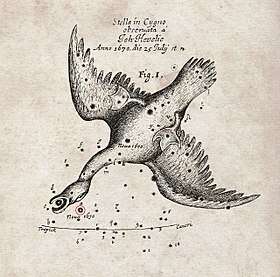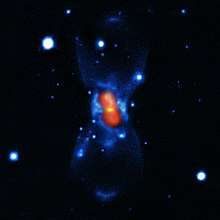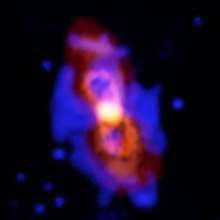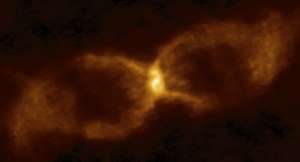CK Vulpeculae
| Observation data Epoch J2000.0 Equinox J2000.0 | |
|---|---|
| Constellation | Vulpecula |
| Right ascension | 19h 47m 38.0s[2] |
| Declination | +27° 18′ 48″[2] |
| Apparent magnitude (V) | max 2.6[2] |
| Characteristics | |
| B−V color index | 0.7[3] |
| Variable type | unknown[3] |
| Astrometry | |
| Distance | 2,280 ± 490[4] ly (700±150[4] pc) |
| Details | |
| Luminosity | 0.9[3] L☉ |
| Temperature | 14,000 – 100,000[3] K |
| Other designations | |
| Database references | |
| SIMBAD | data |
CK Vulpeculae (also Nova Vulpeculae 1670) is the oldest reliably-documented nova. It consists of a compact central object surrounded by a bipolar nebula.
Models suggest CK Vulpeculae may not be a classic nova; rather it may be classified as a Luminous red nova which is the result of two main sequence stars colliding and merging.[6] A 2018 study found it was most likely the result of an unusual collision of a white dwarf and a brown dwarf that merged some time between 1670 and 1672.
Eruptive history

CK Vulpeculae was discovered on June 20th 1670 by Voituret Anthelme and independently on July 25 by Johannes Hevelius. It had a brightness maximum of approximately magnitude 3 at its discovery after which it faded. A second maximum of approximately 2.6 magnitude was observed in March 1671, after which Johannes Hevelius and Giovanni Cassini observed it throughout spring and summer until it faded from naked-eye view in late August 1671. A last weakly visible brightness maximum of approximately 5.5 to 6 magnitude was observed by Hevelius in March 1672 and finally faded from view late May.[7]
This was the first nova for which there are multiple and reliable observations. The next nova to be documented as comprehensively was Nova Ophuichi 1841.[7]
Identification

John Flamsteed, who was elaborating his catalogue during these years, assigned the star the Flamsteed designation 11 Vulpeculae,[5] which has been noted later by Francis Baily as one of Flamsteed lost stars, because it had not been detectable for centuries.[8]
In 1981, a point source near the centre of a small nebula was identified as CK Vulpeculae, with an estimated red magnitude of 20.7.[9][7] Later observations cast doubt on that identification,[10] and it is now known to be a background object. That object and another star are thought to be seen though dense nebulosity associated with CK Vulpeculae which causes them to vary dramatically in brightness.[4]
CK Vulpeculae now consists of a compact central object with gas flowing out at approximately 210 km/s into a bipolar nebula.[4] A 15" path of nebulosity seen in the 1980s lies at the centre of a 70" bipolar nebula.[11] A compact radio source is seen at the centre of this nebula, and an infrared point source, but it has not been detected at optical wavelengths.[3] The ionisation of the nebula and its radio emission indicate that the central source is still very hot and relatively luminous.[4] It is either inside of a cloud of cold (~ 15 K) dust or the cloud is in front of it from the Earth's perspective. Molecular gas in the vicinity is rich in nitrogen relative to oxygen.[6]
Distance
The distance to CK Vulpeculae cannot be determined accurately. Assumptions about its maximum possible luminosity and a position beyond known nebulosity give a distance of 550 ± 150 pc.[7][3] Measurements of the expansion of the nebulosity assumed to have been produced in 1670 give a distance of 700 ± 150 pc. There are gas clouds at 500 pc and 2 kpc, but only the first is detected in the spectrum of CK Vulpeculae, placing strong constraints on the possible distance.[4]
Properties

The luminosity of the central object, estimated from infrared dust emission, is about 0.9 L☉.[3] The luminosity required to energise the observed nebulosity is calculated at 3 L☉ from an object at 60,000 K[4] At the time of its eruption, the luminosity of CK Vulpeculae is calculated to have been at least 24,000 L☉. Known ionic emission lines in the spectrum, and unidentified absorption features in the infrared indicate a temperature between 14,000 K and 100,000 K.[3]
Astronomers using the Atacama Large Millimetre Array (ALMA) and the Northern Extended Millimeter Array (NOEMA) radio telescopes to study CK Vulpeculae have found the first convincing evidence of radioactive debris outside the Earth's Solar System. The molecule in question is made up of a radioactive isotope of aluminium with 13 protons and 13 neutrons bound together with atoms of fluorine.[13]
Nature of the eruption
In the past, a luminous red nova merger, very late thermal pulse, or a diffusion-induced nova have all been suggested but there are problems with all these explanations.[3] An analysis of the structures and isotopic abundances in the remaining nebula using the Atacama Large Millimeter Array (ALMA) in 2018 concluded that the nova and associated nebula were caused by the unusual merger of a white dwarf and brown dwarf.[14]
References
- ↑ "Through the Hourglass". www.eso.org. Retrieved 8 October 2018.
- 1 2 3 Downes, Ronald A; Webbink, Ronald F; Shara, Michael M; Ritter, Hans; Kolb, Ulrich; Duerbeck, Hilmar W (2001). "A Catalog and Atlas of Cataclysmic Variables: The Living Edition". The Publications of the Astronomical Society of the Pacific. 113 (784): 764. arXiv:astro-ph/0102302. Bibcode:2001PASP..113..764D. doi:10.1086/320802.
- 1 2 3 4 5 6 7 8 9 Evans, A.; et al. (2016). "CK Vul: A smorgasbord of hydrocarbons rules out a 1670 nova (and much else besides)". Monthly Notices of the Royal Astronomical Society. 457 (3): 2871–2876. arXiv:1512.02146. Bibcode:2016MNRAS.457.2871E. doi:10.1093/mnras/stw352.
- 1 2 3 4 5 6 7 Hajduk, M.; van Hoof, P. A. M.; Zijlstra, A. A. (11 June 2013). "CK Vul: evolving nebula and three curious background stars". Monthly Notices of the Royal Astronomical Society. 432 (1): 167–175. arXiv:1312.5846. Bibcode:2013MNRAS.432..167H. doi:10.1093/mnras/stt426.
- 1 2 Morton, Wagman (2003). Lost Stars. Blacksburg, Virginia: McDonald and Woodward. p. 494. ISBN 0-939923-78-5.
- 1 2 Kaminski, Tomasz; Menten, Karl M.; Tylenda, Romuald; Hajduk, Marcin; Patel, Nimesh A.; Kraus, Alexander (March 23, 2015). "Nuclear ashes and outflow in the eruptive star Nova Vul 1670". Nature. 520 (7547): 322–4. arXiv:1503.06570. Bibcode:2015Natur.520..322K. doi:10.1038/nature14257. PMID 25799986.
- 1 2 3 4 Shara, M. M.; Moffat, A. F. J.; Webbink, R. F. (July 1, 1985). "Unraveling the oldest and faintest recovered nova - CK Vulpeculae (1670)". Astrophysical Journal. 294: 271–285. Bibcode:1985ApJ...294..271S. doi:10.1086/163296.
- ↑ Baily, Francis (1845). The Catalogue of Stars of the British Association for the Advancement of Science. London: Richard and John E Taylor. p. 77. ISBN 1165133253.
- ↑ Shara, M. M.; Moffat, A. F. J. (July 1, 1982). "The recovery of CK Vulpeculae (Nova 1670) - The oldest 'old nova'". Astronomical Journal. 258 (Part 2 Letters to the Editor): L41–L44. Bibcode:1982ApJ...258L..41S. doi:10.1086/183826.
- ↑ Naylor, T.; Charles, P. A.; Mukai, K.; Evans, A. (1992). "An observational case against nova hibernation" (PDF). Monthly Notices of the Royal Astronomical Society. 258 (3): 449–456. Bibcode:1992MNRAS.258..449N. doi:10.1093/mnras/258.3.449.
- ↑ Hajduk, M; Zijlstra, Albert A; Van Hoof, P. A. M; Lopez, J. A; Drew, J. E; Evans, A; Eyres, S. P. S; Gesicki, K; Greimel, R; Kerber, F; Kimeswenger, S; Richer, M. G (2007). "The enigma of the oldest 'nova': The central star and nebula of CK Vul". Monthly Notices of the Royal Astronomical Society. 378 (4): 1298. arXiv:0709.3746. Bibcode:2007MNRAS.378.1298H. doi:10.1111/j.1365-2966.2007.11825.x.
- ↑ "Stellar Corpse Reveals Origin of Radioactive Molecules - Observations using ALMA find radioactive isotope aluminium-26 from the remnant CK Vulpeculae". www.eso.org. Retrieved 31 July 2018.
- ↑ Kamiński, T; Menten, K. M; Tylenda, R; Karakas, A; Belloche, A; Patel, N. A (2017). "Organic molecules, ions, and rare isotopologues in the remnant of the stellar-merger candidate, CK Vulpeculae (Nova 1670)". Astronomy & Astrophysics. 607: A78. arXiv:1708.02261. Bibcode:2017A&A...607A..78K. doi:10.1051/0004-6361/201731287.
- ↑ Eyres, Stewart; Evans, Aneurin; Zijlstra, Albert; Avison, Adam; Gehrz, Robert; Hajduk, Marcin; Starrfield, Sumner; Mohamed, Shazrene; Woodward, Charles; Wagner, R. Mark (16 September 2018). "ALMA reveals the aftermath of a white dwarf--brown dwarf merger in CK Vulpeculae" (PDF). Retrieved 18 September 2018.
